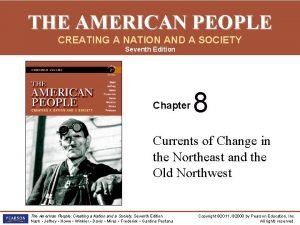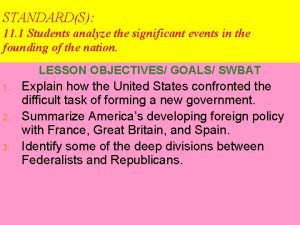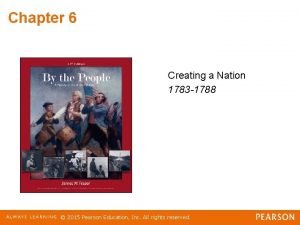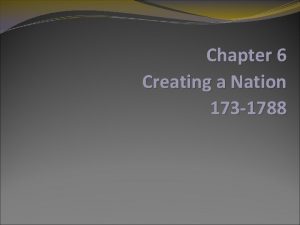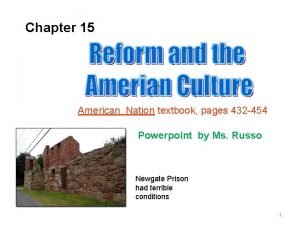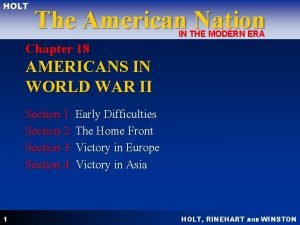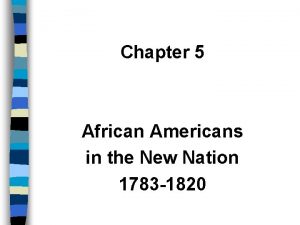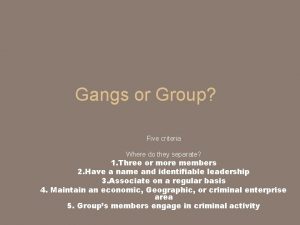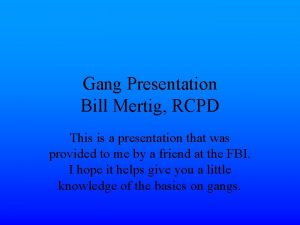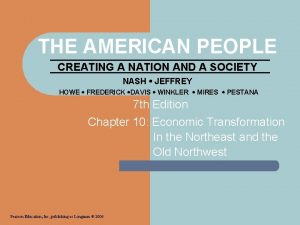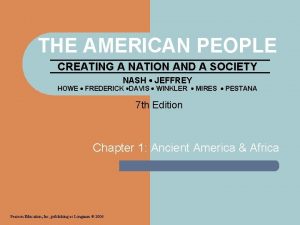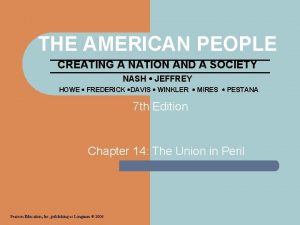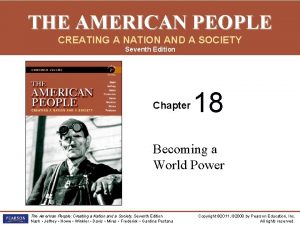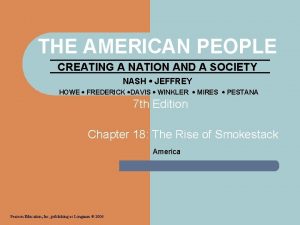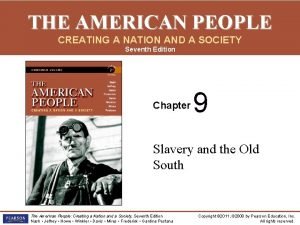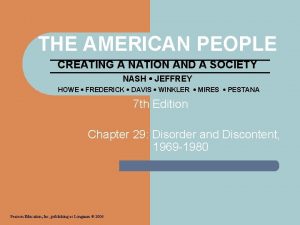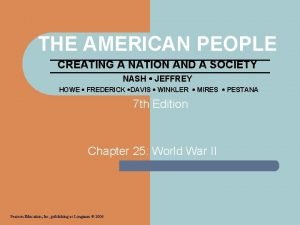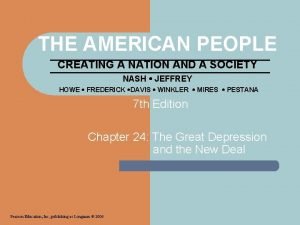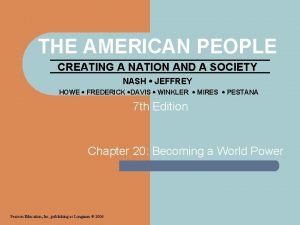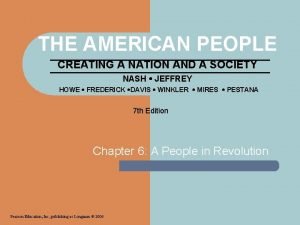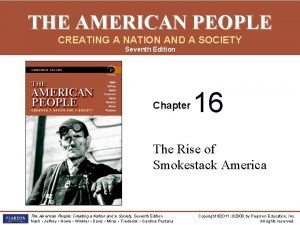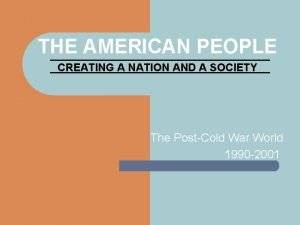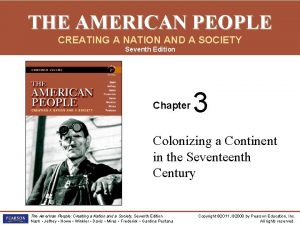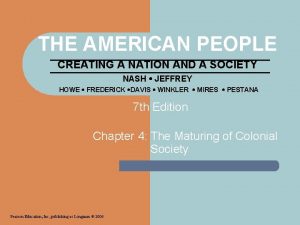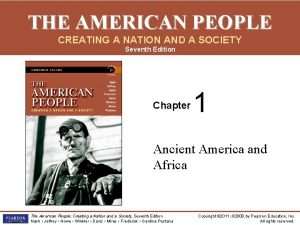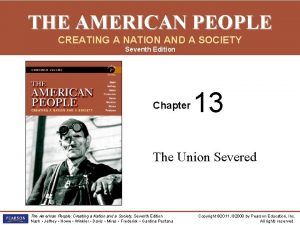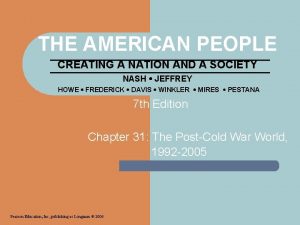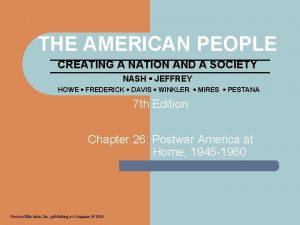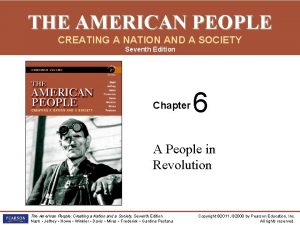THE AMERICAN PEOPLE CREATING A NATION AND A














































- Slides: 46

THE AMERICAN PEOPLE CREATING A NATION AND A SOCIETY NASH JEFFREY HOWE FREDERICK DAVIS WINKLER MIRES PESTANA 7 th Edition Chapter 23: Affluence and Anxiety Pearson Education, Inc, publishing as Longman © 2006

POSTWAR PROBLEMS l l Enthusiasm for social progress evaporated in 1919 and the sense of progress and purpose that the war had fostered withered The year following the end of the war was marked by strikes and violence and by fear that Bolsheviks, blacks, foreigners, and others were destroying the American way of life

THE RED SCARE l As a result of the Russian Revolution, Americans imagined Communists, rather than anarchists, as the worst possible threat to their way of life – – – In the spring of 1919, the Russians announced a policy of worldwide revolution Communist uprisings in Hungary and Bavaria further frightened Americans Immediately after the war there were maybe 25, 000 communists in the United States

THE “RED MENACE” AND THE PALMER RAIDS l Workers in the U. S. suffered from wartime inflation, which had almost doubled the prices between 1914 and 1919 while most wages remained the same – – l l During 1919, more than 4 million workers participated in 4000 strikes Wanted higher wages, shorter hours and sometimes more control over their workplace The ideals of Socialism and Communism were tied, often erroneously, to the American labor movement and the strikes were often broken, sometimes with force On April 28, 1919, bomb was discovered in a package delivered to the mayor of Seattle followed by one the next day that blew the hands off the maid of a former senator from Georgia – – Additional bombings occurred in June causing Attorney General A. Mitchell Palmer to organize a special antiradical division within the Justice Department headed by J. Edgar Hoover and to launch a series of raids in November 1919 Some 5000 suspected radicals were arrested and 600 were deported Raids fanned the flames of fear and intolerance which continued throughout the decade though the worst of the “Red Scare” was over by 1920 Fostered a number of patriotic organizations such as the American Legion and the Daughters of the American Revolution

THE KU KLUX KLAN l Organized in Georgia by William J. Simmons, the new Klan, unlike the original which took almost anyone who was white, was thoroughly Protestant and explicitly anti-foreign, anti-Semitic, and anti-Catholic – – l Opposed teaching of evolution; glorified old-time religion; supported immigration restrictions; denounced short skirts, petting and “demon rum”; and upheld patriotism and the purity of women Wanted to keep blacks in their place and were willing to use violence when peaceful aims failed 1920 s saw rapid growth of the Klan

THE KU KLUX KLAN l In some states Women of the Klan (WKKK) made up more than half the membership – – – l At the peak of its power, the Klan had several million members, many of them middle class – l Also campaigned for women’s rights and the equal treatment of all white, Protestant women For both sexes the Klan served as a social club At least half the members came from urban areas and the Klan was especially strong in working-class neighborhoods of Detroit, Indianapolis, Atlanta and Chicago In some states, especially Indiana, Colorado, Oregon, Oklahoma, Louisiana and Texas, the Klan influenced politics and determined some elections The Klan’s power declined after 1925 because of a series of internal power struggles and several scandals

ETHNIC AND RELIGIOUS INTOLERANCE l One result of the Red Scare and the fear of foreigners and radicals was the conviction of two Italian anarchists, Nicola Sacco and Bartolemeo Vanzetti who had been arrested in 1920 for murdering a guard during the robbery of a shoe factory in Massachusetts – – – l The two were convicted and sentenced to die in the summer of 1921 on what seemed to be flimsy evidence Case took on symbolic significance and many intellectuals in the U. S. and Europe rallied to their defense After a special commission reaffirmed the verdict, the two were executed in August 1927 A general spirit of intolerance permeated the decade and became more fixed and formal

A PROSPERING ECONOMY l Economy soared after a postwar depression in 1921 and 1922 – – l Fueled by new technology, more efficient planning and management, and innovative advertising, industrial production almost doubled during the decade and the gross national product rose by 40 percent Construction boom created new suburbs around American cities while skyscrapers transformed the cities themselves While the American economy boomed, much of the rest of the world suffered

THE RISING STANDARD OF LIVING l l In the 1920 s, the enameled tub, toilet and washbasin became standard in many American homes Americans of the post-war years had more leisure time, a shorter work week and more paid vacation than Europeans American diet improved during the decade, health improved and life expectancy increased Educational opportunities expanded with high school attendance expanding from 1 in 10 to 6 in 10 and more than a million people

THE RISE OF THE MODERN CORPORATION l Corporate mergers began to increase at a rate greater than anytime since the 1890 s – l A new type of professional manager emerged – – – l By 1930, the 200 largest corporations controlled almost half the corporate wealth Marketing and advertising became as important as production Many businesses began to spend more on research To encourage workers to be efficient, managers introduced incentives such as pensions, recreation facilities, cafeterias, paid vacations and profit-sharing plans—welfare capitalism Planning was key to the new corporate structure

ELECTRIFICATION l 1920 s marked the climax of the “second Industrial Revolution” powered by electricity and producing a growing array of consumer goods – – – By 1919 more than two-thirds of American homes had electricity Electricity brought dozens of gadgets and labor saving devices into the home though the actual time the average housewife spent was not reduced For many poor urban and rural women all that changed was a greater sense of the difference between their lives and that of those better off

A GLOBAL AUTOMOBILE CULTURE l The manufacture of the automobile underwent enormous growth in the postwar years, stimulating the rubber, steel, and petroleum industries – – – l Auto also led to the decline of the small crossroads store as well as many small churches – – l The auto forced the construction and improvement of streets and highways which was done, in part, with federal aid after the passage of the 1916 Federal Highway Act The auto also created new suburbs along with filling stations, the diner and the overnight cabin. Traffic lights, stop signs, billboards and parking lots appeared as did increasing levels of pollution Tractor changed method of farming and trucks altered the marketing of farm products Buses began to eliminate the one-room schoolhouse while cars allowed young people to escape the chaperoning of parents Automobile also became a sign of status and transformed advertising

A GLOBAL AUTOMOBILE CULTURE l By 1926, three-fourths of the cars sold were bought on some kind of deferred-payment plan – l Installment buying spread to a number of other consumer items In the 1920 s, the car came within the reach of middle-class buyers and by the end of 1929 there were 27 million registered cars – – – Most European autos were custom made and many European companies did not adopt the assembly line production system until the 1930 s European governments subsidized car production for military purposes which delayed the creation of inexpensive cars European government also adopted safety standards and required national licenses for vehicles and drivers before the United States did because in America the states created the rules

HENRY FORD l l Ford adapted the assembly line and the concept of interchangeable parts to the production of autos In 1914, announced he was increasing the minimum pay to $5 per day (almost twice the national average for factory workers) – – l Ford ruthlessly pressured his dealers and used them to solve his financial difficulties – l Did it to ensure a dependable workforce Work was repetitious and numbing and if line shut down, workers were released without pay Used spies on the assembly line and fired workers and executives at the least provocation While Ford’s Model T set the standard when it was first made, by the late 1920 s, Ford’s refusal to make major changes put the Model T at a major disadvantage behind other sleeker, more modern cars – – Ford’s wages dropped below the industry average In 1927, Ford introduced the Model A and built the gigantic Rouge River plant to mass produce it

THE EXPLODING METROPOLIS l l Automobile led to a decline of the streetcar and the trolley New suburbs, carefully planned and restricted to whites, emerged Automobile also allowed industry to move into the suburbs Biggest land boom of all occurred in Florida until the 1926 hurricane temporarily ended it – l Detroit and Los Angeles also experienced tremendous growth Cities expanded horizontally in the 1920 s but city centers grew vertically


A COMMUNICATIONS REVOLUTION l During the 1920 s, the number of homes with telephones increased from 9 to 13 million – l By end of the decade, half of American homes were still without phones Radio symbolized the technological and communicational changes of the 1920 s – – First radio station began broadcasting in Detroit in 1920 and by 1922 there were 500 stations Classical music was soon joined by news analysis and coverage of important events and then live dramas Serials made radio a national medium By the end of the decade, people in all sections of the country were humming the same popular songs

A COMMUNICATIONS REVOLUTION l Movies grew rapidly during the 1920 s – – l l l By mid-decade movie production had moved to Hollywood and giant firms dominated the industry Movies created well known stars and attracted viewers across class, regional and generational lines Movies had the power to influence attitudes and ideas Sports figures also became stars as increased leisure time, the auto, radio and mass-circulation newspapers turned sports into mass spectator events 1927 marked the beginning of the new age of mechanization and progress – Among the many firsts was the solo flight of Charles Lindbergh across the Atlantic

HOPES RAISED, PROMISES DEFERRED

CLASH OF VALUES l l During the 1920 s, radio, movies, advertising and masscirculation magazines promoted a national secular culture which emphasized consumption, pleasure, upward mobility and even sex which clashed with traditional values of work, thrift, church, family and home The Scopes Trial in Dayton, Tennessee, pitted those who had accepted the views of Charles Darwin against evangelical Christians who believed faith in the Gospel message was crucial to living a virtuous life on earth – – Clarence Darrow was hired by the American Civil Liberties Union as attorney for the defense while William Jennings Bryan was engaged by the World Christian Fundamentalist Association to act for the prosecution Despite Darrow’s destruction of most of Bryan’s points, the jury found Scopes guilty

RELIGIOUS FUNDAMENTALISM l Fundamentalists believed in the literal interpretation and the infallibility of the Bible and that Jesus Christ was the only road to salvation – – l Rejected secularism, liberal theology, pluralism, the Social Gospel and any sense that reform on earth could lead to perfection Throughout he 1920 s and 1930 s, attendance and Christian colleges and the circulation of fundamentalist periodicals and newspapers increased dramatically Evangelical ministers such as Billy Sunday and Aimee Semple Mc. Pherson reached large audiences – Radio spread the message of the fundamentalist preachers and attracted numerous converts to those ministers who could readily adapt to the new communications technology

IMMIGRATION AND MIGRATION l l l Immigrants and anyone else perceived as “un. American” seemed to threaten the old ways An act passed in 1882 prohibited the entry of criminals, paupers and the insane and special agreements between 1880 and 1908 restricted Chinese and Japanese immigration First strongly restrictive immigration law was passed in 1917 over Wilson’s veto and it required a literacy test and prohibited the immigration of certain political radicals – – – 1921: Congress limited European immigration in any one year to 3 percent of the number of each nationality present in the country in 1910 1924: changed the quota to 2 percent of those in the country in 1890 and effectively prohibited Japanese immigration 1927: National Origins Act set an overall limit of 150, 000 European immigrants a year with more than 60 percent coming from Great Britain and Germany

IMMIGRATION AND MIGRATION l l l Restrictive immigration policies sponsored by the Republicans helped attract Poles, Jews and Italians to the Democratic party Immigration restriction cut off the stream of cheap labor though by exempting the Western Hemisphere, new laws opened the country to Mexican laborers who poured into California and the Southwest as well as northern industrial cities African Americans migrated north in large numbers between 1915 and 1920 – – – l Most were unskilled While they improved their lives through migration, most were crowded into segregated housing and faced prejudice and hate Often black men moved first and brought their families later In 1919 in Chicago there was a race riot that killed several dozen and wounded hundreds in four days of rampaging through the black sections of the city – Race riots broke out in numerous other cities as well

Mexican Population, 1930

MARCUS GARVEY: BLACK MESSIAH l Marcus Garvey, a Jamaican, saw self-help as a means of political empowerment by which African peoples would reclaim their homelands from European powers – – – By 1919 had established 30 branches of his Universal Negro Improvement Association in the U. S. and the Caribbean Also set up the newspaper The Negro World, the Black Cross Nurses, and a chain of grocery stores, millinery shops and restaurants Advocated the return of blacks to Africa Won converts mainly among lower-middle-class blacks especially through his message that blacks should be proud to be blacks After his Black Star shipping line collapsed, Garvey was sentenced to 5 years in jail for using the mail to defraud investors President Coolidge commuted the sentence and deported Garvey

THE HARLEM RENAISSANCE l A group of black writers, artists and intellectuals who settled in Harlem after the war led a movement that explored the ambivalent role of blacks in America while celebrating their pride in being black – – – l Jazz was an important force in Harlem and many prosperous whites came to listen to black musicians – l Alain Locke was the father of the movement Langston Hughes Claude Mc. Kay Jean Toomer Zora Neale Hurston Jazz was also an extremely successful export to Europe Problem for many Harlem writers was how to be both black and intellectual – Many African American writers felt alienated from American society

THE LOST GENERATION l Many white intellectuals, writers and artists also felt alienated from the materialism, conformity and provincial prejudice they saw dominating American life – – l F. Scott Fitzgerald, Ernest Hemingway, E. E. Cummings and T. S. Eliot moved to Europe Sherwood Anderson, Sinclair Lewis, and H. L. Mencken criticized American society without leaving the country Despite writers’ criticisms of business-dominated American culture, literature flourished in the 1920 s

WOMEN STRUGGLE FOR EQUALITY l Women acquired more sexual freedom in the 1920 s – – – l Contraceptives, especially the diaphragm, became more readily available Margaret Sanger organized the first American birth control conference in 1921 though most states still made the selling or prescribing of birth control illegal and federal laws prohibited sending information about it through the mail Family size declined from 3. 6 children in 1900 to 2. 5 in 1930 and young people were more inclined to marry for love rather than security More women expected sexual satisfaction in marriage and felt that divorce was the best solution for an unhappy marriage Double standard still persisted Electricity, running water, washing machines, vacuum cleaners and other labor-saving devices made housework easier for the middle class though they did not affect rural or urban working-class women – Even middle-class women discovered the time it took to do housework had not been reduced as standards of cleanliness went up

WOMEN STRUGGLE FOR EQUALITY l More women worked outside the home though their share of manufacturing jobs fell – – l The image of the flapper in the 1920 s promised more freedom and equality for women they achieved – l Greatest expansion of jobs was in white collar occupations that were becoming feminized—secretary, bookkeeper, clerk and telephone operator While more married women had jobs, they were low paying jobs and most single women expected marriage to end their employment For secretaries and teachers marriage often led to dismissal from their jobs Disparity between male and female wages widened during the decade with women only earning 57 percent of male wages in 1930 Flapper was frivolous and daring, not professional and competent Winning the vote for women did not ensure equality – – National League of Women Voters was organized to educate women about politics An Equal Rights Amendment was opposed by many women who felt the amendment would cancel special legislation to protect women in industry


RURAL AMERICA IN THE 1920 s l American farmers, as a rule, did not share in the prosperity of the 1920 s. – l Advancements in agriculture (pesticides and advanced fertilizers) and use of tractors increased yield per acre and allowed more acres to be cultivated thereby increasing production just as demand was declining – l A vicious cycle of overproduction to meet demands continually lowered market prices of produce, forcing many farmers into the poorhouse Many farmers were also vulnerable to the forces of nature Large commercial farmers using mechanized equipment produced most of the cash crops – – – Small farmers found themselves unable to compete with agribusiness and increasing numbers left the farms Few farmers could afford the products of new technology No relief came from Congress

THE WORKERS’ SHARE OF PROSPERITY l While hundreds of thousands of workers improved their standard of living in the 1920 s, inequality grew – – l Real wages increased 21 percent between 1923 an 1929 but corporate dividends went up nearly two-thirds in the same period Richest 5 percent of the population increased their share of the wealth from a quarter to a third and the wealthiest one percent controlled 19 percent of all income Among workers there was a great disparity – – – Employees on the auto assembly line or in new factories producing radios saw their wages go up and their hours decline Yet the majority of working class families did not earn enough to move much beyond subsistence Labor union membership fell during the 1920 s and many unions struggled

THE BUSINESS OF POLITICS l l Big business prospered in the 1920 s and the image of the businessman rose further Government reduced regulation, lowered taxes, and cooperated to aid business expansion at home and abroad – Business and politics were especially aligned during the decade

HARDING AND COOLIDGE l Since Theodore Roosevelt died in 1919, Republicans nominated Warren G. Harding as president and Calvin Coolidge as vicepresident – – – l Teapot Dome Scandal: Albert Fall, secretary of the interior, had illegally leased government-owned oil reserves in Wyoming – l The Democrats nominated Governor James Cox Harding won in a landslide but died of a heart attack in August 1923 Only after Harding’s death, did the full extent of his friends’ corruption and scandals come out Illegal activities were also discovered in the Veterans Administration and elsewhere throughout the government Coolidge was honest and no scandal touched his administration so he was easily re-elected in 1924 – His secretary of the treasury, Andrew Mellon, set out to lower individual and corporate taxes

HERBERT HOOVER l l As secretary of commerce, Hoover used the force of the federal government to regulate, stimulate, and promote but he believed firmly in free enterprise and local volunteer action to solve problems Hoover believed that the primary role of the federal government was to educate and promote

GLOBAL EXPANSION l l The U. S. cooperated with many league agencies and conferences, though it did not join the League or the World Court, and it took the lead in trying to reduce naval armaments and solve the problems of international finance caused by the war The 1920 s was a decade of dramatic expansion in business, finance, and trade for the United States – l US became a creditor nation and maintained involvement in Latin America US called the Washington Conference on Naval Disarmament in 1921 that resulted in fixing the tonnage of capital ships at a ratio of US and Britain, 5; Japan, 3; and France and Italy, 1. 67 – Japan agreed only after the U. S. agreed not to fortify its Pacific island possessions

GLOBAL EXPANSION l American foreign policy in the 1920 s tried to reduce the risk of international conflict, resist revolution and make the world safe for trade and investment – – – l At the end of the war, European countries owed the US $10 billion but France and Britain could not pay and tried to get the US to forgive the debt – – l By the end of the decade, the US controlled the financial affairs of 10 Latin American countries In Nicaragua, the marines left in 1925 only to return the next year to try in vain to contain the revolution of Augusto Sandino who would be murdered in 1934 by General Anastasio Somoza, who, followed by his two sons, controlled the country for the next 40 years Mexico began to nationalize foreign oil and mineral holdings in the mid-20 s but the US solved the issue through negotiations European ability to pay was further undermined by high US tariff barriers and by the inability of Germany to pay the reparations it owed under the Versailles Treaty US backed a plan engineered by Charles Dawes to restructure German reparations, helping with a loan to Germany In 1928 the Kellogg-Briand pact sought to outlaw war

THE SURVIVAL OF PROGRESSIVISM l The Sheppard-Towner Maternity Act of 1921 allotted 1 million dollars a year to educate expectant mothers on proper self -health issues and child care – Controversial from the start, the law was repealed in 1929


TEMPERANCE TRIUMPHANT l In 1919, Congress passed the Volstead Act which banned the brewing and selling of alcoholic beverages with more than one-half of one percent alcohol – l Prohibition probably reduced total drinking in the U. S. , especially in rural areas and working-class neighborhoods – – – l l In June 1919, the Eighteenth Amendment, prohibiting the manufacture, sale and transportation of intoxicating beverages was ratified Fewer arrests for drunkenness occurred and deaths from alcoholism declined Most people who wanted to drink found a way Bartenders invented the cocktail to disguise the taste of cheap alcohol and middle and upper class women began to drink in public for the first time Prohibition also produced great bootlegging rings that were often tied to organized crime Many supporters of prohibition gradually came to support its repeal

THE ELECTION OF 1928 l l In August 1927, Coolidge announced he did not plan to run again and the Republicans nominated Herbert Hoover Democrats nominated Alfred Smith, who was Catholic – – While on the surface the candidates appeared different, especially in religion and ethnic background, they were actually very similar Hoover won in a landslide though the campaign revitalized the Democratic party

STOCK MARKET CRASH l The prosperity of the decade came to a screeching halt in 1929 with the collapse of the nation’s stock market – – Many investors had responded to the booming economy by buying stocks on margin (borrowing to invest) though even at the peak of the boom only about 1. 5 million Americans owned stock An overextension of the market caused a crash with a represented loss of over $26 billion on paper


DISCOVERING U. S. HISTORY ONLINE Red Scare (1918 -1921) http: //www. newman. baruch. cuny. edu/digital/redscare/default. htm l The Trial of Sacco and Vanzetti http: //www. courttv. com/archive/greatesttrials/sacco. vanzetti/ l Automotive History www. mel. lib. mi. us/business/autos-history. html l Emergence of Advertising in America http: //scriptorium. lib. duke. edu/eaa/ l Chicago: Destination for the Great Migration http: //www. loc. gov/exhibits/african/afam 011. html l Titanic http: //www. nationalgeographic. com/society/ngo/explorer/titanic/movie. html l Ernest Hemingway http: //www. npg. si. edu/exh/hemingway/ l

DISCOVERING U. S. HISTORY ONLINE Tennessee vs. John Scopes http: //www. law. umkc. edu/faculty/projects/ftrials/scopes. htm l The 1920 s http: //www. louisville. edu/~kprayb 01/1920 s. html l The Marcus Garvey and Universal Negro Improvement Association Papers Project http: //www. isop. ucla. edu/africa/mgpp/ l Harlem 1900 -1940: An African American Community http: //www. si. umich. edu/CHICO/Harlem/ l Photographs from the Golden Age of Jazz http: //lcweb 2. loc. gov/ammem/wghtml/wghome. html l Negro League Baseball http: //nku. edu/~diesmanj/harlem_intro. html l Urban Leisure http: //www. jazzagechicago. com/ l

DISCOVERING U. S. HISTORY ONLINE The Harlem Renaissance http: //www. nps. gov/inde/visit. html l Temperance and Prohibition http: //prohibition. osu. edu l The Coolidge Era and the Consumer Economy, 1921 -1929 http: //lcweb 2. loc. gov/ammem/coolhtml/ccpres 00. html l Calvin Coolidge http: //www. potus. com/ccoolidge. html l Herbert C. Hoover http: //www. potus. com/hchoover. html l October 24, 1929 http: //sweb. uky. edu/~msunde 00/hon 202/p 4/nyt. html l
 The american people creating a nation and a society
The american people creating a nation and a society Creating a new nation
Creating a new nation Chapter 6 creating a nation
Chapter 6 creating a nation Chapter 6 creating a nation
Chapter 6 creating a nation State vs nation
State vs nation State vs nation
State vs nation Nation vs state
Nation vs state The american nation textbook answers
The american nation textbook answers Holt american nation
Holt american nation Chapter 5 african american in the new nation
Chapter 5 african american in the new nation American nation chapter 4
American nation chapter 4 American nation chapter 4
American nation chapter 4 Simon city royals tattoos
Simon city royals tattoos Native mob gang signs
Native mob gang signs Larry hoover net worth
Larry hoover net worth People of media
People of media What is the meaning of where is the love by black eyed peas
What is the meaning of where is the love by black eyed peas How to understand graphs and charts
How to understand graphs and charts Hát kết hợp bộ gõ cơ thể
Hát kết hợp bộ gõ cơ thể Slidetodoc
Slidetodoc Bổ thể
Bổ thể Tỉ lệ cơ thể trẻ em
Tỉ lệ cơ thể trẻ em Voi kéo gỗ như thế nào
Voi kéo gỗ như thế nào Thang điểm glasgow
Thang điểm glasgow Bài hát chúa yêu trần thế alleluia
Bài hát chúa yêu trần thế alleluia Các môn thể thao bắt đầu bằng từ đua
Các môn thể thao bắt đầu bằng từ đua Thế nào là hệ số cao nhất
Thế nào là hệ số cao nhất Các châu lục và đại dương trên thế giới
Các châu lục và đại dương trên thế giới Cong thức tính động năng
Cong thức tính động năng Trời xanh đây là của chúng ta thể thơ
Trời xanh đây là của chúng ta thể thơ Mật thư tọa độ 5x5
Mật thư tọa độ 5x5 101012 bằng
101012 bằng Phản ứng thế ankan
Phản ứng thế ankan Các châu lục và đại dương trên thế giới
Các châu lục và đại dương trên thế giới Thơ thất ngôn tứ tuyệt đường luật
Thơ thất ngôn tứ tuyệt đường luật Quá trình desamine hóa có thể tạo ra
Quá trình desamine hóa có thể tạo ra Một số thể thơ truyền thống
Một số thể thơ truyền thống Cái miệng nó xinh thế chỉ nói điều hay thôi
Cái miệng nó xinh thế chỉ nói điều hay thôi Vẽ hình chiếu vuông góc của vật thể sau
Vẽ hình chiếu vuông góc của vật thể sau Nguyên nhân của sự mỏi cơ sinh 8
Nguyên nhân của sự mỏi cơ sinh 8 đặc điểm cơ thể của người tối cổ
đặc điểm cơ thể của người tối cổ Thế nào là giọng cùng tên? *
Thế nào là giọng cùng tên? * Vẽ hình chiếu đứng bằng cạnh của vật thể
Vẽ hình chiếu đứng bằng cạnh của vật thể Fecboak
Fecboak Thẻ vin
Thẻ vin đại từ thay thế
đại từ thay thế điện thế nghỉ
điện thế nghỉ
